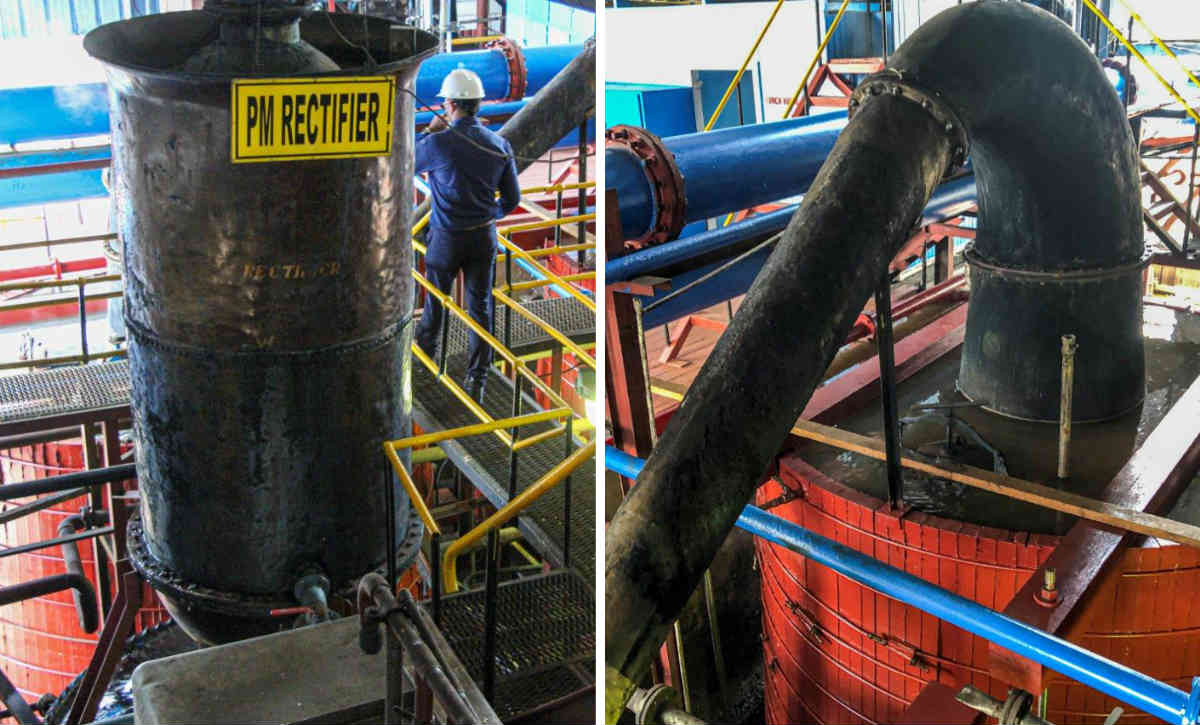The Caribbean’s lush, sun-painted islands are frequently touted as the center of the rum world; after all, they were the birthplace of rum. However, some of the most iconic and legendary rum comes from a South American country 1,300 miles to the southeast of the Caribbean Sea: Guyana. Here, a distillery tends to a living museum of distillation techniques and equipment that once made rum for the daily tot served to British navy sailors.
Guyana is a study in contrasts. The coastal plains are covered with sugar cane fields and are below sea level; seawalls protect them. Inland, tropical rainforests cover the vast majority of the country, similar to those in neighboring Brazil. Guyana means “land of water,” which is entirely apropos, as its landscape is crossed with countless man-made canals and enormous rivers. One such river, the Demerara, runs past the capital city of Georgetown and Diamond Estate. Once one of many sugar cane estates, Diamond is now home to Demerara Distillers Ltd., which makes rum at the on-site Diamond distillery.
El Dorado Rums
Demerara Distillers Ltd., aka DDL, is best known for its house brand, El Dorado Demerara Rum. In the early 1990s, the company launched El Dorado 15-Year, arguably the first long-aged premium rum. It helped kickstart rum’s premiumization over the three decades since.

El Dorado
El Dorado’s core lineup runs from a lightly aged and filtered 3-year rum to a 21-year rum costing around $100. In between are expressions with a minimum of 5, 8, 12, and 15 years of aging. At the very high end of El Dorado’s offerings are two extremely limited editions—one aged a minimum of 25 years, another a blend of rums between 33 and 50 years—celebrating the 50th anniversary of Guyana’s independence from the British crown in 1966. A bottle will set you back $3,000 or more should you be able to find one.
DDL also makes the budget-friendly Diamond Reserve brand, with white, dark, spiced, coconut, and 151-proof expressions.
The Diamond distillery makes far more rum than required for the El Dorado and Diamond Reserve lines. Much of that rum goes to other brands. Among them is Lemon Hart, a brand dating back to 1804, and whose 151-proof rum is synonymous with Tiki cocktails. Other brands using rum from Diamond distillery are Lambs Navy Rum, Hamilton Guyana, Skipper, and Old Sam. If a rum label says “Demerara rum” on it, it came from the Diamond distillery. DDL is the registered proprietor of the Demerara Rum geographical indication, and the Diamond distillery is the only rum distillery in Guyana.

Matt Pietrek
Diamond Distillery’s Stills
Part of the allure of Demerara rums is the vast range of flavor profiles emanating from the dozen stills at Diamond. Three of those stills draw particular attention: They’re all over a century old, and astonishingly, are made from wood! Not just any old wood, but Guyanese greenheart, which is extremely heavy, sturdy, and resistant to decomposing when wet.
All three wooden stills (as well as two more metal stills) came to Diamond from other distilleries. Over the last century, the number of Guyanes rum distilleries shrank from dozens to just one: Diamond Estate. Luckily, some of these stills were saved from demolition and still make rum today with the same flavor profile (marques) they made previously. For that reason, the Diamond distillery is known as the living museum of Guyana’s rum history.
While El Dorado’s lineup celebrates blending rums from multiple stills, DDL also has several special limited release expressions celebrating the unique flavors of the three wooden stills: Enmore, Versailles, and Port Mourant (picured at top). Each is named after the estate where it once resided.

Matt Pietrek
The Port Mourant still is a particularly noteworthy still, and it’s my favorite still anywhere. (We all have a favorite rum still, right?) The Port Mourant (PM) still consists of two enormous wooden vats, along with a retort and rectifier. It’s a unique configuration not found anywhere else in the world. The flavor from the Port Mourant still is immediately identifiable to rum geeks. It’s heavy, oily, and brings to mind the aroma of young, green wood freshly stripped of its bark.
The PM still’s flavor profile is strongly associated with the legendary British Navy rum of the 19th and 20th centuries. Some people, myself included, say that PM rum is the bedrock of the British Navy blend. A navy rum without PM is simply unthinkable.
While the British Navy stopped making rum 50 years ago (in 1970), the Pusser’s brand keeps the navy rum tradition alive. Like the other brands mentioned earlier, Pusser’s Rum is made by Demerara Distillers. And yes, Pusser’s current blend includes a healthy dose of Port Mourant rum.
Hopefully, the above has impressed on you just how important DDL’s role in the rum world is. There’s so much to the story of Guyana’s rum history and Demerara Distillers Ltd. Should you wish to learn more, check out my deep dives into the subject here and here.



